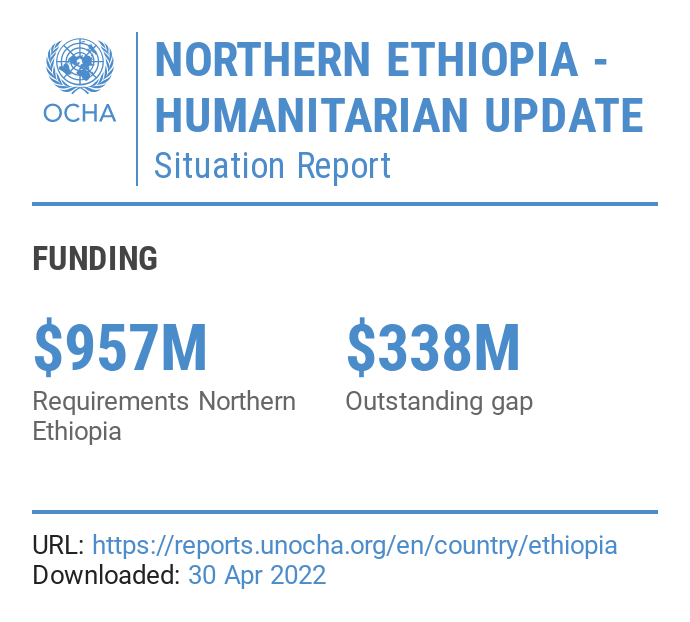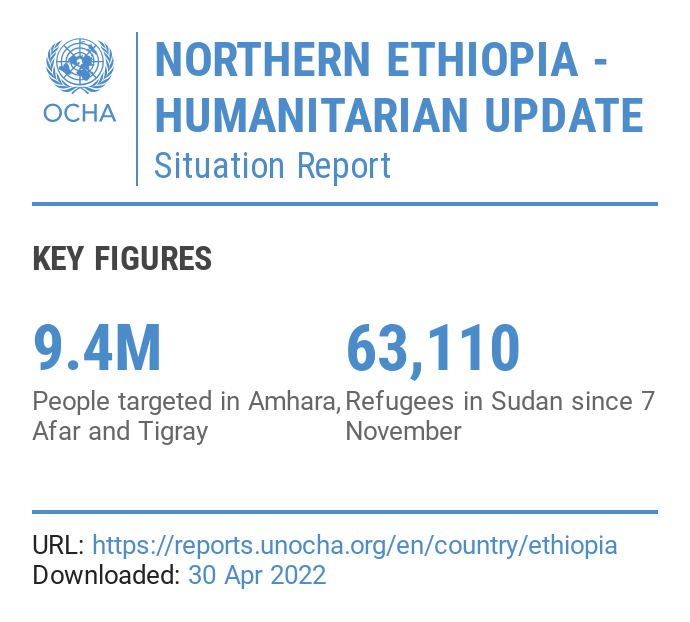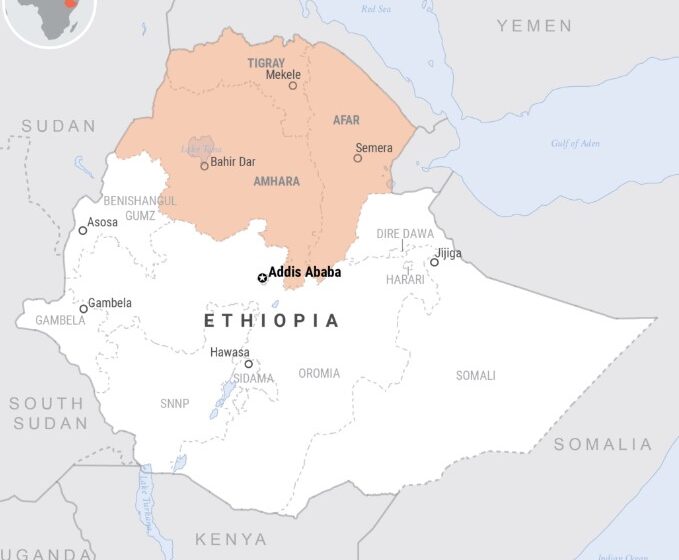
Situation Report: Northern Ethiopia – Humanitarian Update
Source: OCHA
Highlights
- 3,400 MT of food brought into Tigray between 1 and 25 April. At least 4,675 MT of food are required every day to complete current food distribution by mid-May.
- More than 46,000 students across 144 schools in Wag Hemra Zone, South Wello, North Wello Oromia zones of Amhara Region received school feeding services during the reporting week.
- Some 16,500 IDPs in Amhara Region have been assisted with essential NFI kits during this reporting week.
- 82,884 people received food assistance in Fanti Raise and Kilbati Rasu zones in Afar during the reporting period and overall 698,503 peopl assisted as of 25 April.
Background
Disclaimer
OCHA Ethiopia prepares this report with the support of Cluster Coordinators. The data/information collected covers the period from 19-25 April 2022. In some cases, access and communication constraints mean that updates for the period are delayed and cannot be reflected. The next issue of the sitrep will be published on 5 May 2022.
Visual
Results from the Northern Ethiopia Response Plan (since 1 May)
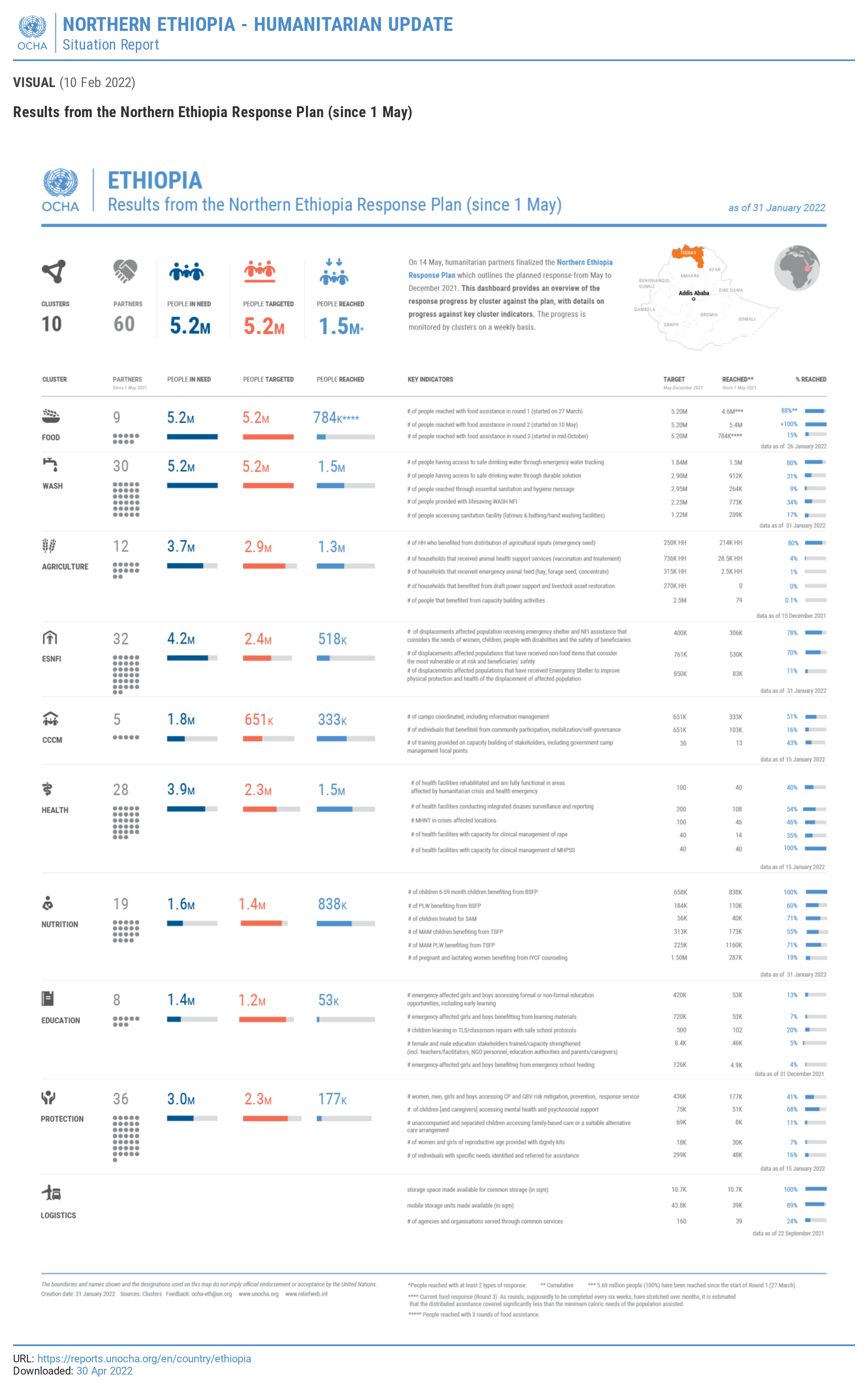
Background
Situation Overview
The overall humanitarian situation in northern Ethiopia remains dire. In Afar Region, a recent nutrition assessment conducted in four IDP sites indicated a proxy global acute malnutrition (GAM) rate of 36 per cent, moderate malnutrition (MAM) rate of 30 per cent and severe acute malnutrition (SAM) rate of 6 six per cent. The lack of adequate treatment services for the moderately malnourished people in the IDP sites, gaps in WASH services particularly in Semera IDP sites and insufficient food being distributed are worsening the IDPs’ nutrition status. Looking at Tigray, of 18,597 children under 5 years screened during the reporting period, 5,176 (27.8 per cent) were GAM , of which 584 children were severely malnourished. And out of 7,335 pregnant and nursing mothers screened, 4,206 (57.2 per cent) were malnourished during the same period. Generally, the level of food insecurity can be expected to worsen in the coming months as humanitarian assistance is not delivered at scale and on time across all regions. In addition, in Tigray, the prospects for harvesting even half of last year’s crop production during the 2022 main cropping season (Meher/summer) are bleak unless sufficient amounts of seeds and fertilizers are delivered ahead of the planting season.Reports indicate that farmers in Tigray have been preparing the ground to plant seeds, and are ready to use locally available seeds if no better option in availed to them fast.
The education of children continues to be affected. Overall, an estimated 1.39 million children in Tigray are entering their third year without access to learning. An additional 144,200 primary school students and 25,000 children accessing alternative learning programmes are at risk of dropping out of school due to food and other basic supply shortage. Some 46,598 teachers across the region also require immediate life-saving multi-purpose cash and food assistance to keep schools open. Similarly in Amhara Region, more than 558 schools (around 6 schools in the region) across North Gondar, North Wello, Wag Hemra, Wolkayit Tegedie, Setit Humera zones are still closed due to security reasons. And more than 97 schools in North Wello, Wag Hemra and North Gondar zones are temporarily sheltering IDPs and armed forces.
Despite efforts to mobilize resources and scale-up the response, it has not reached the required scope and scale required to respond to the several crises in northern Ethiopia. With the relative improvement in humanitarian road access into Tigray since 1 April, nearly 3,400 MT of food was brought into the region through the three humanitarian convoys that have so far reached Mekelle from Semera (on 1/2 April, on 15 April and 25 April). The latest convoy on 25 April consisted of 74, of which 71 trucks arrived in Tigray carrying food, nutrition, and WASH NFI supplies; three trucks remain behind in Abala due to mechanical issues. An additional 6 fuel tankers arrived in Tigray. All of the food supplies were dispatched to prioritized woredas, including Mekelle, Abi-Adi town (Central), Adwa town (Central), Axum town (Central), Adigrat town (Eastern), Maichew town (Southern), Sheraro town (North Western) and two refugee camps in North Western Zone. Distribution is currently ongoing. Despite this progress, the scale and available resources are not near enough to meet the identified needs. After the nearly 3,400 MT of food brought and dispatched in Tigray, partners remained with only around 756 MT of food commodities in stock within Tigray as of 27 April. The majority of the stock is pulses and vegetable oil, and there is merely enough stock (14 MT) to feed about 833 people with a balanced three-commodity food basket for one round.
Reports of lack of adequate assistance reported across all other sectors is also rampant. In Amhara, basic needs particularly shelter needs for IDPs remain largely unmet. The majority of IDPs are living in makeshift shelters due to insufficient resources to construct emergency shelters. The living conditions of displaced persons living in congested collective centers in Wag Hemra Zone is worsening exposing vulnerable groups to additional health and protection risks. In Afar Region, service monitoring conducted during the reporting week in Afdera and Silsa Guya IDP sites revealed inadequate WASH, shelter/NFIs and health services available to the IDPs. The host communities are equally affected by the lack of these services as they also rely on these services in the IDP sites, particularly for access to water.
Overall, the humanitarian response in northern Ethiopia remains constrained by security concerns and administrative limitations such as the inability to bring in sufficient supplies, fuel, and cash to Tigray and limited access to people in hard-to-reach areas across northern Ethiopia. In Amhara Region, humanitarian partners are facing access challenges to reach conflict-affected populations in Raya Kobo woreda of North Wollo Zone, Abergele, Tsagbji woredas and some kebeles of Ziquala woredas of Wag Hemra Zone, and in Adi Arekay and some kebeles of Tselemt woredas of North Gondar Zone. During the reporting week, the security situation along the road from Kewet/Shewa Robit, North Shewa to Kemise Oromo Zone has been tense. Similarly in Afar, IDPs in Balbal, Adukwa, Garbena and Gimirida sites in Afar cannot be reached due to insecurity.
Visual
Humanitarian Access in northern Ethiopia
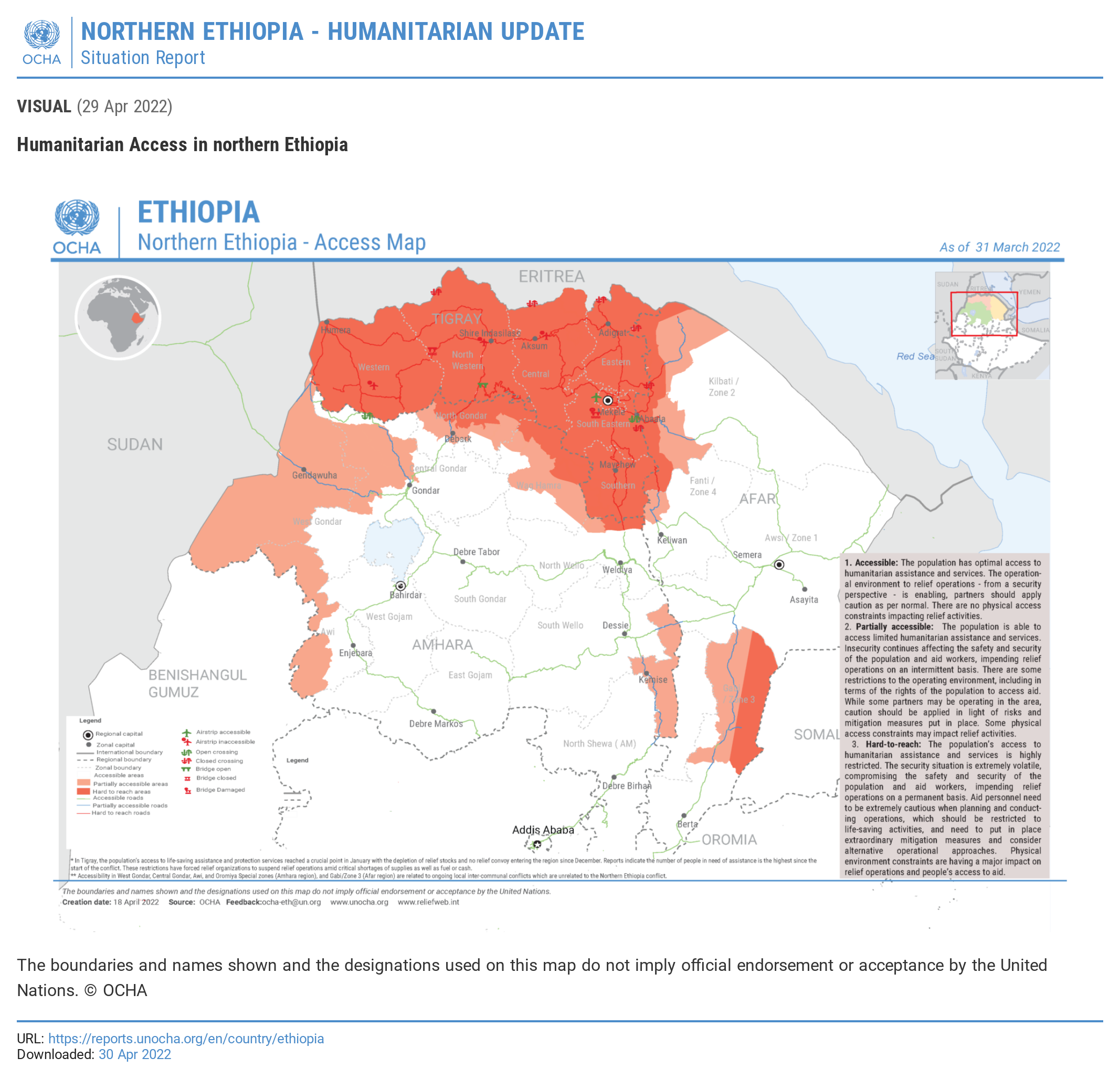
Emergency Response
Humanitarian Preparedness and Response
In Tigray, food partners have only assisted 4,128 people with 4 MT of food between 14 and 20 April with each beneficiary only receiving one type of food commodity due to the resource shortfall. Overall, 1,337,045 people (21 per cent of the planned target) were assisted with 16,312 MT of food across six zones between mid-October (when Round 3 food distribution started in Tigray) and 20 April. As each round, which is supposedly a six-week cycle, has stretched over months, it is estimated that on average, the distributed rations covered significantly less than the minimum caloric needs of the people assisted. At least 4,675 MT of food commodities (or 115 trucks, equivalent to common food basket for around 276,000 people) are required to move into Tigray every day to complete Round 3 distribution by mid- May and reach 5.2 million people.
In Amhara, during the reporting period, 35,280 people were assisted by humanitarian partners in North Gondar Zone with 598 MT of food under the 2022 bridging round; 69,077 people were assisted by JEOP with 423 MT of food as part of Round 5 distribution and with 1,1171 MT of food under the 2022 bridging round. While WFP completed Round 5 distribution, EDRMC and JEOP have reached 92 and 95 per cent of their target respectively as of 24 April. WFP and JEOP have also started food distribution under the 2022 bridging round on 10 March so far assisting 698,503 people with 11,840 MT of food.
In Afar, food partners assisted 82,884 people with 1,405 MT of food in Fanti Rasu and Kilbati Rasu zones during the reporting period. Overall, 698,503 people were assisted with 11,178 MT of food under Round 5 as of 25 April. Some 58,223 IDPs in Semera Town, Aabla, Erebti, Konaba, and Megale woredas also received food assistance as part of the Round 5 allocation.
In Tigray, of 18,597 children under 5 years screened during the reporting period, 5,176 (27.8 per cent) were malnourished, including 584 children severely malnourished. Meanwhile, out of 7,335 pregnant and nursing mothers screened, 4,206 (57.2 per cent) have been identified as malnourished. Following the screening, 517 cases were admitted in the outpatient therapeutic treatment for severe acute malnutrition; 43 children were admitted in the inpatient facility with severe acute malnutrition and medical complication. Additionally, 3,398 children were admitted for treatment for moderate acute malnutrition, while 4,206 women were admitted for management of acute malnutrition.
Some 16,500 IDPs in Amhara Region have been assisted with essential NFI kits during this reporting week. Despite the operational constraints, cluster partners commenced the construction of communal shelters in Jarra camp, North Wollo Zone. Eight communal shelters (each 6 units) are constructed so far. In Tigray, 112, 725 people (57,490 female) received ES/NFI support between 1 January and 25 April 2022, and 16,500 people have been assisted with essential NFI kits during this reporting week. Meanwhile, 9,000 plastic sheets have been airlifted to Mekelle between 14 and 21 April. The plastic sheets will be used to repair the damaged shelters and to expand the existed IDP sites in Mekelle and Shire. The distribution of life-saving cash assistance to 2,000 households (with the sum ETB 1,000 each) is ongoing in Sheraro IDP sites. An additional 57 households also received cash assistance in Abi Adi sites. Preparation work to commence similar assistance in Selekleka IDP site has also been completed during the reporting period. Meanwhile, twenty three survivors of gender-based violence from Shire IDP sites received ETB 2,300 each during the reporting week, while 45 unaccompanied children from Shire IDP sites were supported with ETB 45,000.
In Amhara Region, the construction of the 10x30m hanger and digging of holes to erect wooden poles for the two additional hangers constructed in the Paper Factory IDP site in Debre Birhan were completed during the reporting week. The site will be able to accommodate more IDPs and decongest existing shelters.
In Afar, 149 IDPs from Berhale Woreda IDP site received CRI support; two water trucks per day are supplying water to IDPs in Semera IDP site and one water truck per day is supplying water to IDPs in Semera Industrial Park IDP site. IDPs in Semera IDP site participated in liquid and dry waste disposal-land excavation work during the reporting week.
Looking at the response in the education sector, 20,324 students across 38 schools in Wag Hemra Zone and 26,003 students across 126 schools in Sekota Zuria Woreda in Wag Hemra Zone, Worebabu in South Wello, Habru North Wello, Raya Kobo in North Wello and Bathi Zuria in Oromia Zone of Amhara Region received school feeding services during the reporting week, while 640 children (306 girls) attending non-formal learning classes in Mekelle IDP camps benefitted from a school meal during the same period.
Emergency Response
Funding Update
The cumulative funding gap for both the 2021 Mid-Year Review of the Humanitarian Response Plan and the 2021 revised Northern Ethiopia Response Plan stands at more than US$1.1 billion. An estimated $619 million has been mobilized towards the Northern Ethiopia Response Plan, and $656 million for response towards the Mid-Year Review Humanitarian Response Plan. However, this is far from sufficient to cover the humanitarian needs.
At the start of 2022, the Ethiopian Humanitarian Fund (EHF) carried over a balance of US$ 6.7 million, after committing $24.3 million for the second 2021 standard allocation. A total of $8 million received in confirmed contributions from the governments of Canada, Germany, Sweden and Switzerland. An additional $6.4 million is in the pipeline from the government of Sweden for 2022 programming. These will increase the EHF estimated fund balance to $21.1 million. The continued support from donors demonstrates efforts to mobilize resources to enable humanitarian partners delivering assistance to conflict and natural disasters-affected people.
Visual
Inter-sectoral gaps
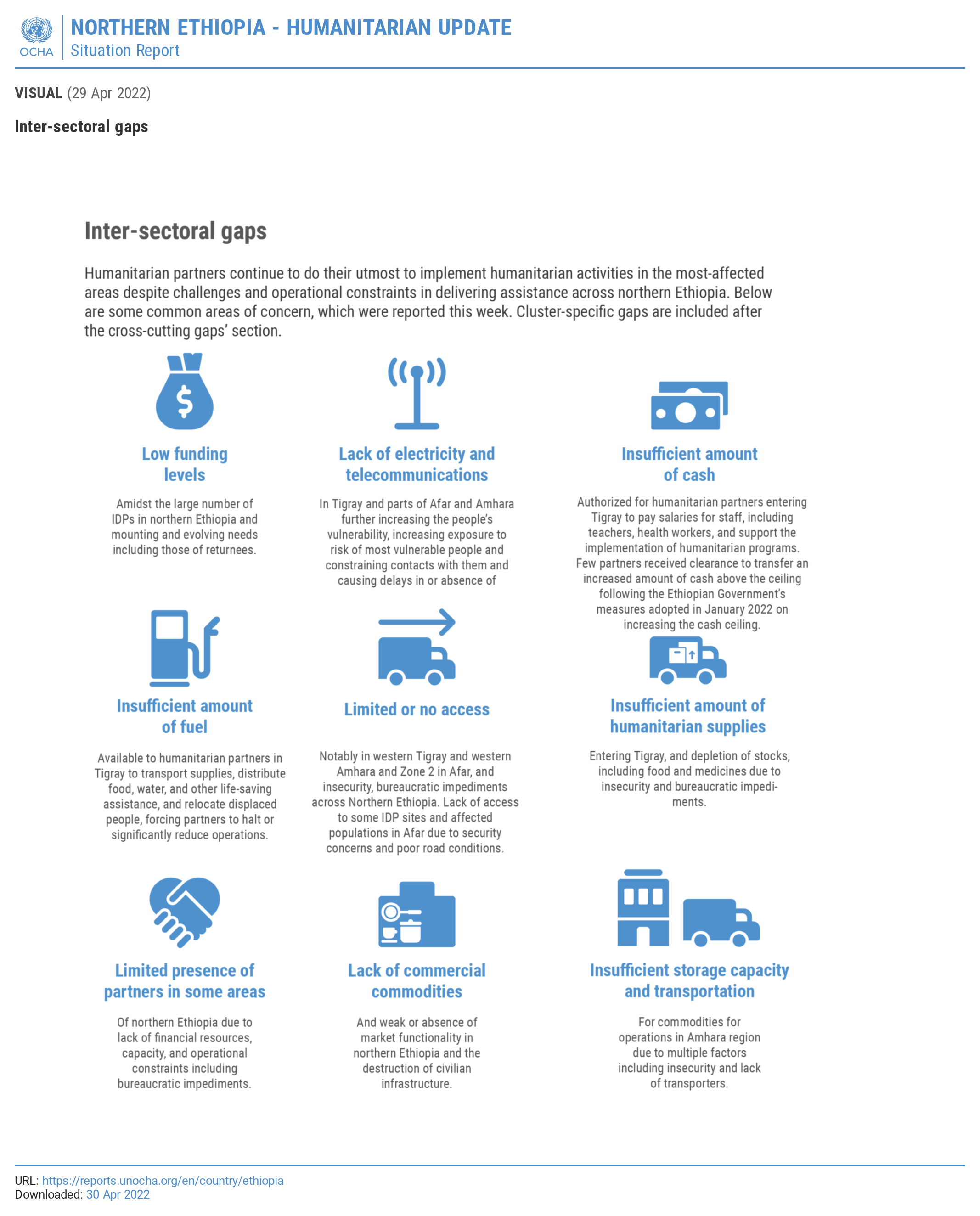
Cluster Status
Agriculture
Needs
- Seeds and fertilizer are urgently needed across northern Ethiopia as the Meher planting season is just weeks away. The implication of a third consecutive poor agricultural season will be devastating on the lives and livelihoods of the conflict-affected population. This includes 60,000 MT of fertilizer, 50,000 tons of improved crop seeds, 40,000 liters of pesticides and 34,000 liters of fungicides in Tigray.
- Also in Tigray, vaccines, drugs and equipment are required for at least 12 million livestock.
- In Amhara Region, 3.3 million farmers are in need of at least one type agricultural interventions, out of these, 2.6 million farmers are targeted for multiple types of agricultural interventions.
Response
- In Tigray, only about 10 per cent (~ 5,354 MT) of the required fertilizer is currently being mobilized by four partners.
- Also in Tigray,9 per cent of required staple crop seed is being mobilized by seven partners and about 2.52 per cent of required vegetable seed is being mobilized by six partners.
- Additional 500 chicks at the Model Koekoek Poultry Farm are expected to be produced in the coming weeks bringing the total to 1,500 birds. The farm will retain 1,000 breeder in stock and will start selling chicks to out growers.
- Drought power support will be provider to rejuvenate 50,000ha of farmland belonging to farmers who lost their draught animal power during the conflict.
- No input received from Afar and Amhara regions this week.
Gaps
—
Camp Coordination and Camp Management
Needs
- Support the safe and dignified relocations of IDPs from schools to alternative shelters and of voluntary returns of IDPs to their places of origin in all northern Ethiopia, including the ongoing relocation in North Wollo, Wag Hemra and Debre Birhan in Amhara Region.
- Provision of CCCM support to 1.8 million people in Tigray.
- Provide critical medication for people with chronic diseases and skin infections in IDP sites in Tigray. Scabies cases continue to increase in all IDP sites in North-Western Zone.
- Food, non-food items, firewood, cooking oil, milling support, drinking water, dignity kits, blankets, mattresses, kitchen sets, medication, education service and school materials for the displaced children at IDP sites across northern Ethiopia.
- Additional space to reduce the risk of communicable diseases, including COVID-19, and to provide privacy and protection at IDP sites across northern Ethiopia.
- Support mechanisms for people living with disabilities in IDP sites.
Response
- In Tigray, during the reporting week, IOM in coordination with local relocated 212 households from Adwa Correction Center to Adwa Industrial Zone (AIZ). All relocated households were supported with firewood, and the distribution of 300 traditional injera stoves is planned for the coming weeks.
- Distribution of life-saving cash assistance to 2,000 households (with the sum ETB 1,000 each) is ongoing in Sheraro IDP sites. An additional 57 households also received cash assistance in Abi Adi sites. Preparation work to commence similar assistance in Selekleka IDP site has also been completed during the reporting period.
- 23 GBV survivors from Shire IDP sites received ETB 2,300 each during the reporting week, while 45 unaccompanied children from Shire IDP sites were supported with ETB 45,000.
- 2.5 quintals of flour teff was collected from different volunteers in the community and was distributed to 15 vulnerable households (15 KGs each) for the Easter celebration in Dehab Tesfay IDP center in Shire.
- Yekatit 23 IDP site has received an additional 3,700 seedlings from Mekelle Bio-Farm Office (tomato (2,000), lettuce (1,200) and cabbage (500) seedlings).
- Also in Tigray, the construction of 15 mini-communal kitchens and four multi-purpose shades in Adwa sites have been completed during the reporting week. Partitioning works of Nigiste Saba Preparatory unfinished building in Shire is 80 per cent complete.
- In Amhara Region, the construction of the 10x30m hanger and digging of holes to erect wooden poles for the two additional hangers constructed in the Paper Factory IDP site in Debre Birhan of North Shewa Zone are completed. The site will be able to accommodate more IDPs and decongest existing shelters.
- In Wag Hamra/Sekota, a total of 4,041 people have been relocated to Weleh relocation site from the temporary Mybulit site. A Women and Youth committees was established in Weleh relocation site (50 per cent women).
- Three blocks of leaking roofs at the Dabat IDP site were maintained during the reporting week; installation of 27 kitchen doors is ongoing at the Dabat IDP site; while COVID 19 mass sensitization and awareness-raising activities were conducted in all IDP sites in North and Central Gondar zones during the reporting week.
- Bush clearing is ongoing by CCCM partner DEC. Approximately 6,2 hectares of bush have been cleared in North Wollo Zone (Jarra IDP site). The frames of 7 communal shelters is completed, while 3 other frame is under construction. Three units of communal shelters are being covered with plastic sheets (roofing, side walling and partitioning).
- In Afar Region, 149 IDPs from Berhale Woreda IDP site received CRI support; two water trucks per day are supplying water to IDPs in Semera IDP site and one water truck per day is supplying water to IDPs in Semera Industrial Park IDP site. IDPs in Semera IDP site participated in liquid and dry waste disposal-land excavation work during the reporting week.
Gaps
- Increased needs given the growing number of IDPs in Afar and Amhara contrasted with the available resources.
- Limited information on IDPs including movement tracking in Afar.
- Lack of sufficient CCCM partners in Amhara including in the new Jarra and Weleh IDP sites.
- Lack of suitable land for IDP sites in Wag Hemra and Zarima, in Amhara due to the topography.
- Material for site improvement activities in all IDP sites in Amhara due to procurement delays, and in Tigray due to lack of access.
Education
Needs
- Reconstruction and rehabilitation of schools damaged by the conflict: more than 1,000 schools damaged in Tigray affecting an estimated 160,000 students; 4,107 schools in Amhara (25 per cent completely damaged), affecting more than 1.8 million children; and at least 200 schools in Afar damaged, affecting more than 150,000 students.
- Provision of WASH facilities and access to clean water in schools.
- Provision of scholastic material and education supplies, including chalk, blackboards and exercise books for 550,000 children in Tigray and 1.9 million children in Amhara.
- School feeding for 345,000 children in Tigray and 2 million children in Amhara.
- Psychosocial support to 4,400 teachers in Tigray and about 117,000 teachers in Amhara. Construction of 167 temporary learning spaces in Tigray and 712 in Afar.
- In Afar, 245 schools are reported to be closed, while over 53,000 children have been forced out of school due to the conflict.
Response
- In Tigray, provision of Alternative Learning Programmes (ALP), Accelerated School Readiness (ASR) and Early Childhood Development (ECD) classes for IDP children in Adigrat, Shire, Mai Tsebri, Axum and Mekelle (SC4) IDP camps. A total of 9,363 (4,679 girls) aged 5 to 14 are currently enrolled across the programs. 640 children (306 girls) attending non-formal learning classes in Mekelle IDP camps benefitted from a school meal during the reporting week.
- 8,283 children (4,214 girls) benefitted from learning materials in Shire, Adigrat and Axum.
- 34 woreda, zonal and regional education authorities improved their skills on Education in Emergencies, response planning and data enumeration through a Zonal School Reopening Workshop in Shire and training for the WASH in Schools Assessment.
- In Amhara, 250 IDP children (51 per cent girls) received scholastic materials at Jarra IDP site, and two tents were provided for TLSs for Jarra IDP site during the reporting week. Fourteen floor mats were also provided for pre-school children.
- 20,324 students across 38 schools in Wag Hemra Zone and 26,003 students across 126 schools in Sekota Zuria Woreda in Wag Hemra Zone, Worebabu in South Wello, Habru North Wello, Raya Kobo in North Wello and Bathi Zuria in Oromia Zone received school feeding services during the reporting week.
- 343 children (116 girls) have access to primary basic education through Accelerated Learning Program (ALP) in Central Gondar Zone, 2,730 children (1,185 girls) in 11 woredas of North Shewa, Oromo N., South Wello and North Wello zones and 621 Children (281 girls) in 10 woredasof North Shewa, Oromo, South Wello and North Wello zones.
- 53 teachers, school principals, volunteers and PTAs (15 female) from Ziquala and Dehana woredas in Wag Hemra Zone received two days mental health and psychosocial support (MHPSS) training and 787 (212 female) teachers, school leaders and ZED and WEO education personnel (212 female) in Dessie, Woldiya and Kemisie towns.
- No new update received for Afar Region.
Gaps
—
Emergency Shelter & Non-Food Items
Needs
- Sufficient shelters and NFIs for hundreds of thousands of IDPs/returnees living in highly congested and substandard conditions across northern Ethiopia.
- Provision of shelter and NFI assistance to IDPs willing to return to their areas of origin, and to IDPs currently living within host communities across northern Ethiopia.
- In Tigray, the Mekelle City administration and the Head of the Bureau of Labor and Social Affairs have requested for the return exercise to continue for IDPs in the host community as there are over 9000 IDPs in the city who have requested to be returned and to have a return package.
Response
- In Tigray, 112,725 people (57,490 female) received ES/NFI support between 1 January and 25 April 2022.
- 9,000 plastic sheets have been airlifted to Mekelle between 14 and 21 April. The plastic sheets will be used to repair the damaged shelters and to expand the existed IDP sites in Mekelle and Shire.
- The construction of 285 shelters in Adwa Industrial Zone site is successfully completed with the relocation of 210 households into the new site on 20 April 2022.
- Shelter constructions resumed in Mai Dimu relocation site. 580 duplex shelters are being constructed while the construction of 32 duplexes is ongoing. The target is 900.
- In Amhara, 16,500 people have been assisted with essential NFI kits during this reporting week.
- Despite the operational constraints, cluster partners commenced the construction of communal shelters in the newly Jarra camp, North Wollo Zone. Eight communal shelters (each 6 units) are constructed so far.
Gaps
- Delay in site preparation and clearing activities in the newly selected IDPs sites.
- Depletion of stocks to meet rising IDPs needs vis-à-vis low funding and resources.
Food
Needs
- More than 9 million people need food assistance in northern Ethiopia.
- Provision of food assistance in hard-to-reach areas in Tigray, Amhara, and Afar.
- Provision of food to the newly displaced people in Kobo in North Wollo Zone,in Sekota and Ziquala in Wag Hamra Zone, and provision of food to the 20,000 IDPs relocated to Jarra and Weleh, in Amhara.
- In Afar, more than 600,000 people in the region are targeted for food assistance.
Response
- In Tigray, only 4,128 people were assisted with 4 MT of food in Indesilassie and Tsimbla between 14 and 20 April. The beneficiaries only received one type of food commodity due to stock shortage (i.e, 400 people received 5 kilograms of wheat, and 3,728 people received 0.45 liters of vegetable oil). In addition, 5,200 refugees in Adi Harush and May Ayni camps in North Western Zone were assisted with around 93 MT of food during the same period.
- Overall, between mid-October (when Round 3 food distribution started in Tigray) and 20 April, food partners have assisted 1,337,045 people (21 per cent of the total planned caseload) with 16,312 MT of food in Central (114,309), Eastern (166,560), Mekelle (175,645), North Western (678,762), South Eastern (12,996) and Southern (188,773) zones. As each round, which is supposedly a six-week cycle, has stretched over months, it is estimated that on average, the distributed rations covered significantly less than the minimum caloric needs of the people assisted.
- In Amhara, 35,280 people were assisted by WFP in North Gondar Zone with 598 MT of food under the 2022 bridging round; 69,077 people were assisted by JEOP with 423 MT of food as part of Round 5 distribution (in South Gondar, Wag Hemra, North Wollo, West Gojam, North Wollo zones) and with 1,1171 MT of food under the 2022 bridging round during the reporting period. Overall, the three food cluster partners (EDRMC, JEOP and WFP) have assisted 3,988,310 people with 67,452 MT of food under Round 4 distribution (launched on 21 October 2021) and assisted 10,424,092 people with 176,610 MT of food under Round 5 distribution (launched on 22 December 2022). While WFP completed Round 5 distribution, EDRMC and JEOP have reached 92 and 95 per cent of their target respectively as of 24 April. WFP and JEOP have also started food distribution under the 2022 bridging round on 10 March so far assisting 698,503 people with 11,840 MT of food.
- In Afar, food partners assisted 82,884 people with 1,405 MT of food in Fanti Rasu and Kilbati Rasu zones under Round 5 during the reporting period. Overall, 698,503 people were assisted with 11,178 MT of food under Round 5 as of 25 April, including 371,364 people assisted by WFP with 6,295 MT of food (59 per cent of target) and 365,902 people assisted by EDRMC with 4,883 MT of food (33 per cent of target). Some 58,223 IDPs in Semera Town, Aabla, Erebti, Konaba, and Megale woredas also received food assistance as part of the Round 5 allocation.
Gaps
- After the nearly 3,400 MT of food brought and dispatched in Tigray, partners remained with only around 756 MT of food commodities in stock within Tigray as of 27 April. The majority of the stock is pulses and vegetable oil, and there is merely enough stock (14 MT) to feed about 833 people with a balanced three-commodity food basket for one round.
- All food partners are operating on credit, having accrued more than 150 million ETB in debt (about three million USD) due to unavailability of cash. Some partners, have not been able to pay their staff since last year. Access to cash remains restricted and it prevents partners from operating at scale in Tigray.
Health
Needs
- 3.9 million people in Tigray need health services and interventions, and more than 10 million people in Amhara.
- Provision of medical equipment, supplies, vaccines, and medicines including anti-retroviral medicines against HIV and tuberculosis, cholera kits, interagency emergency health kits (IEHKs), malaria and scabies’ medicines, severe acute malnutrition (SAM) kits, and reproductive health kits needed in Tigray.
- Cholera vaccines for the second round of the oral cholera vaccination campaign in Tigray. Anti-rabies vaccines are also needed.
- Provision of food for health workers at health facilities in Tigray as incentive since they have not received salaries in the last eight months.
- An estimated 888,000 children under five years in Tigray and more than 360,000 children in Amhara need polio oral vaccination.
- Provision of essential medical supplies, medicines, and cold chain equipment to Wag Hamra, North Wollo and South Wollo zones in Amhara.
- Provision of family planning commodities and Vitamin A supplies in Woldiya, Dessie, Debark Dabat, Debre Birhan woredas and reproductive health kits in South Wello, Amahra.
- Also in Amhara, more than 500 health facilities, and 1,706 health posts damaged and/or looted due to the conflict need rehabilitation and support.
- In Afar, only 94 health facilities, or 22 per cent of the 414 facilities, are functional, including 2 hospitals and, 31 health centres. The facilities need to be rehabilitated/renovated and provided with the equipment and supplies needed to be operational.
- Provision of medications, treatment, and access to health services. Malaria, typhoid fever, severe acute malnutrition, dysentery, and epidemic typhus were reported as top 5 diseases in Afar.
Response
- In Tigray, twelve health partners provided healthcare services to the affected population in Tigray either through direct support to health facilities or through their Mobile Health and Nutrition Teams (MHNTs) in 30 woredas out of the 88 targeted woredas reaching 23,455 people, with different health services including 15,400 with outpatient consultations.
- During the reporting period, 35.9 MT of HIV supplies were airlifted to Mekelle, the first time since July, 2021.
- In Amhara, 27,804 IDPs were reached with health services during the reporting week, including 10,098 people in North Wello, South Wello and Wag Hamra zones. Of the total IDPs reached, 9,156 received reproductive health services
- In Afra, 15 health partners are responding to health needs to displaced and non-displaced communities in the region, operating 25 MHNTs during the reporting period. 6,491 people, including 3,350 women and girls, provided with outpatient consultations during the week.
- 8,126 people reached with health awareness messages include on Covid-19, antenatal care, and communicable diseases in Afar.
- 172 people, including 52 women, provided with mental health and psychosocial support in Kori and Afdera woredas and in Semara Logiya town in Afar.
- 279 people were provided with emergency health service in IDP sites in Afar, including 48 deliveries.
- Medical equipment was provided to 20 conflict affected and other health facilities in zone 1, 4 and 5.
- 75 reproductive health kits provided to the regional health bureau in Afar for distributed to six health centers and three hospitals.
Gaps
- Limited fuel and medical supplies leading to a reduction in the number of operating mobile health and nutrition teams (MHNTs) in Tigray from 57 a few months ago to 17 five weeks ago and 26 during the reporting period (the latest increase due to availability of medications following the airlifts). The frequency of MHNTs’ field visits was also reduced.
- Shortage of drugs, medical supplies, and equipment to restart essential health services at damaged/looted health facilities across in Amhara. Inadequate medical supplies for the MHNTs as well.
- In Afar, the prevalence of malnutrition is increasing in all conflict-affected areas coupled with the limited humanitarian response for the new IDP sites, and shortage of medical supplies at IDP sites.
Logistics
Needs
- Safe and sustained access and additional transportation routes via road and air to transport the required humanitarian supplies to Tigray.
- Safe and sustained access to hard-to-reach areas in Amhara and Afar regions.
Response
- 100 MT of nutrition and health cargo (58.6 MT of nutrition supplies and 41.4 MT of health supplies) airlifted to Tigray on behalf of three partners during the reporting period.
- In Amhara, 141 MT of shelter items received in Kombolcha warehouse on behalf of one partner
- In Afar, 170 MT of food supplies loaded from Semera warehouse to Afar and Tigray during the reporting period on behalf of two partners. The loaded trucks for Tigray are awaiting convoy movement’s resumption along the Semera-Mekele road.
Gaps
- Lack of funding to airlift supplies to Tigray.
- Lack of storage capacity in Bahir Dar in Amhara, and increased needs of transport in the region.
- Insecurity limiting the capacity to dispatch supplies to areas near the conflict zones across northern Ethiopia.
- Operational challenges along the Semera-Mekelle road.
- Limited transporters to support Afar humanitarian response.
Nutrition
Needs
- About 454,000 children are estimated to be malnourished in Tigray in 2022. Out of this, about 116,000 are severely malnourished and more than 338,000 are moderately malnourished and in need of treatment. About 120,000 pregnant and lactating women (PLW) are estimated to be malnourished.
- More than 460,000 children and more than 307,000 pregnant and lactating mothers need supplementary feeding and about 667,000 pregnant and lactating mothers need blanket supplementary feeding.
Response
- In Tigray, of 18,597 children under 5 years screened during the reporting period, 5,176 (27.8 per cent) were GAM, of which 584 children were severely malnourished. Out of 7,335 pregnant and nursing mothers screened, 4,206 (57.2 per cent) were malnourished.
- Following the screening, 517 cases were admitted in the outpatient therapeutic treatment for severe acute malnutrition; 43 children were admitted in the inpatient facility with severe acute malnutrition and medical complication. Additionally, 3,398 children were admitted for treatment for moderate acute malnutrition, while 4,206 women were admitted for management of acute malnutrition.
- The Infant and young child feeding (IYCF) messaging reached a total of 5,817 caregivers, helping them to improve feeding practices of infants and the young children. 376 pregnant women received iron folic acid supplement.
- WFP received 60MT RUSF from the road convoy this week.
Gaps
—
Protection
Needs
- In Tigray, family tracing and reunification and alternative care services for unaccompanied and separated children (UASC) considering notably the ongoing IDPs return and relocation process.
- Material support (tents, recreational kits) to establish and strengthen new and existing child-friendly spaces at IDP sites across northern Ethiopia.
- Provision of protection services at IDP sites across northern Ethiopia, including child protection, gender-based violence (GBV) and Sexual GBV (SGBV) prevention and response, and mental and psychosocial support.
- NFIs, including aid devices for persons with disability, and dignity kits for women and girls across northern Ethiopia.
- Comprehensive GBV services mapping and localized referral mechanisms, health services for survivors, risk mitigation and prevention activities in northern Ethiopia.
- Scale-up child protection services and referrals in all the three regions.
- UXO, landmine and explosive awareness raising activities across northern Ethiopia.
Response
—
Gaps
- Lack of well-developed alternative care system in Tigray for UASC, and lack of family tracing, reunification, and alternative care due to lack of cash and material for the reunification package.
- Lack of tailored services for children with special needs in Tigray.
- Lack of health, education services and food items for referred children and caregivers in Afar.
Water, Sanitation and Hygiene (WASH)
Needs
- Rehabilitation of sanitation facilities at schools used to shelter IDPs after their relocation across northern Ethiopia.
- Adequate provision of WASH services to prevent disease outbreaks at IDP sites across northern Ethiopia.
Response
- In Tigray, 20 woredas across Central, Eastern, Southern, Mekelle, Southeastern and Northwestern Zones were supported with WASH activities during the reporting week, including 9,643m³ of water supplies reaching 43,921 people and 41,251 people reached through rehabilitation and repair of 15 hand pumps and 8 motorized boreholes.
- Partners expanded 7 kms of water supply system pipeline and benefitted 4,416 IDPs in Sebacare 4 IDP camp. 29 Water quality monitoring sessions were also conducted allowing IDPs to get safe water.
- 176 latrine stances were constructed /rehabilitated benefitting 7,850 people; 77 bathing/shower facility stances repaired/maintained benefitting 2,050 people; 2 m³ latrine pits were desludged allowing 1,600 IDPs to access sanitation facilities.
- 18,818 WASH NFI items were distributed to 9,011 people and 60,011 people were reached through 462 hygiene promotion sessions mass mobilization, cleaning campaign and community sensitization during the reporting week.
- No new updated received from Afar and Amhara regions.
Gaps
- Low stock of key WASH NFIs, including water treatment chemicals, water containers and hygiene supplies in Tigray, Afar and Amhara.
- Limited water quality monitoring due to lack of supplies in Tigray.

